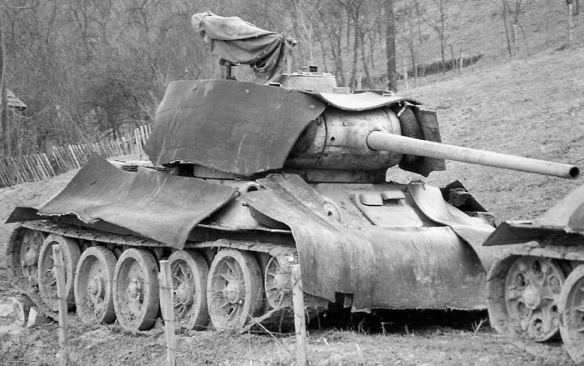Bosnian Serb Army T-34/85s photographed near Doboj in early 1996. The purpose of the rubber sheets was probably to help ward off magnetic anti-tank mines.
Despite Hitler’s defeat in Europe, the T-34 continued to see combat in the Far East throughout the closing days of the Second World War. In August 1945 it was in the forefront of the Red Army’s invasion of Japanese-occupied Manchuria, which took the tanks into North Korea. The Red Army under Zhukov had fought the Japanese in Mongolia in 1939, but the subsequent truce had enabled the Soviets to concentrate on defeating the Nazis in Europe. Stalin, though, had unfinished business and his tanks simply steamrollered their way through the ill-equipped Japanese forces. The latter had nothing capable of taking on the T-34/85’s armour and the Red Army cut through the Imperial Japanese Army like a knife through butter.
Quite remarkably, after the Second World War the T-34 remained in service for almost another five decades. On 25 June 1950 the North Korean People’s Army attacked South Korea, its forces spearheaded by 150 Soviet-supplied T-34/85s.* These were superior to anything else in theatre at the time. While 120 tanks were deployed with the North Korean 105th Armoured Brigade, the North Korean infantry divisions’ self-propelled gun battalions fielded a total of 120 Soviet-supplied SU-76 assault guns. In addition to the tanks of the armoured brigade, personnel from the tank training unit at Sadong, with a further thirty tanks, were assigned to the 7th Division. They deployed on the east–central front for the attack on Inje.
At first the North Koreans’ T-34s rolled all before them – at least until American M26 Pershing tanks armed with a 90mm gun arrived. In the early stages of the fighting the North Koreans also used their tanks in built-up areas to some considerable effect, neutralising UN defenders. The UN forces were to dub them ‘Caviar Cans’. During the assault on Taejon they moved in pairs or singly, carrying supporting infantry. Afterwards the North Koreans began to use their armour much more circumspectly because of the improving American counter-measures.
After the capture of the South Korean capital, the 105th Armoured Brigade became known as the 105th ‘Seoul’ Armoured Division and it was strengthened with the addition of the 308th Self-Propelled Artillery Battalion. By 1953 the North Koreans had seven tank regiments (104th–107th, 109th, 206th and 208th). During the battles for the Pusan pocket the North Koreans received reinforcements that included another eighty T-34/85s; these equipped two new tank units, the 16th and 17th Armoured Brigades. Some were also sent to the 105th Armoured Brigade, but the UN’s air supremacy meant that many were destroyed before they could reach the front. UN estimates at the end of September 1950 were that the entire North Korean T-34 force (then believed to stand at 239 tanks) had been destroyed, whereas the UN forces had lost only sixty tanks.
